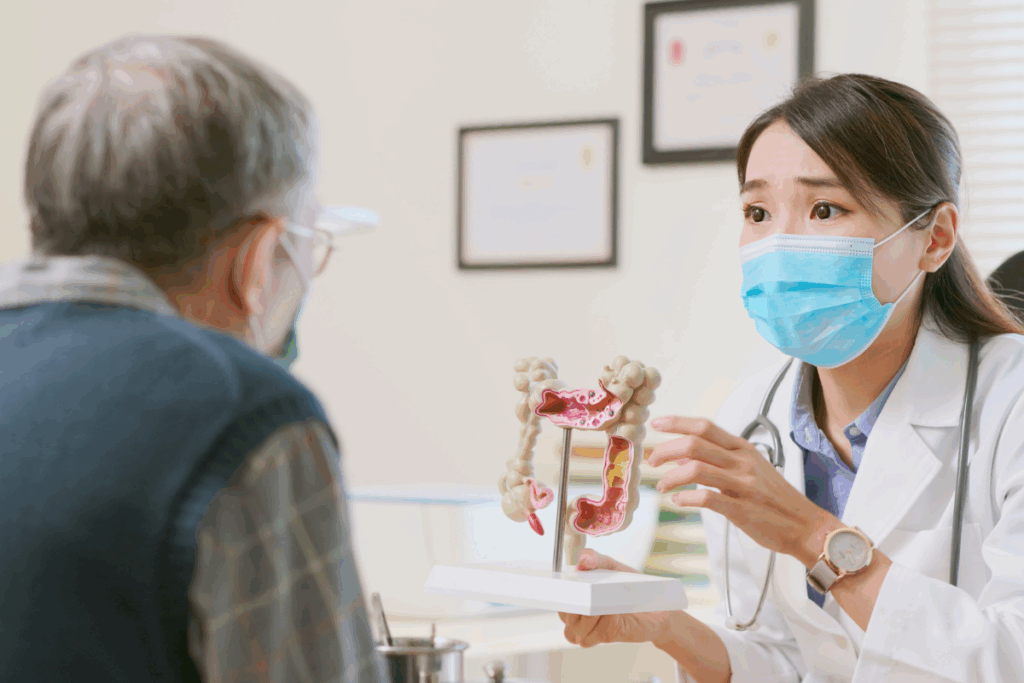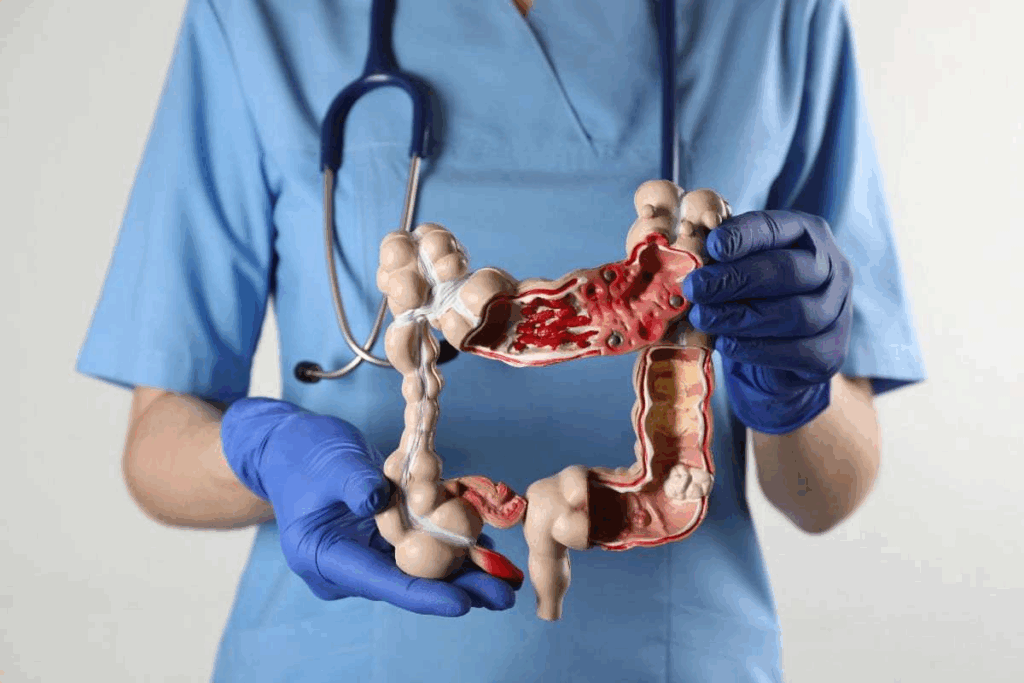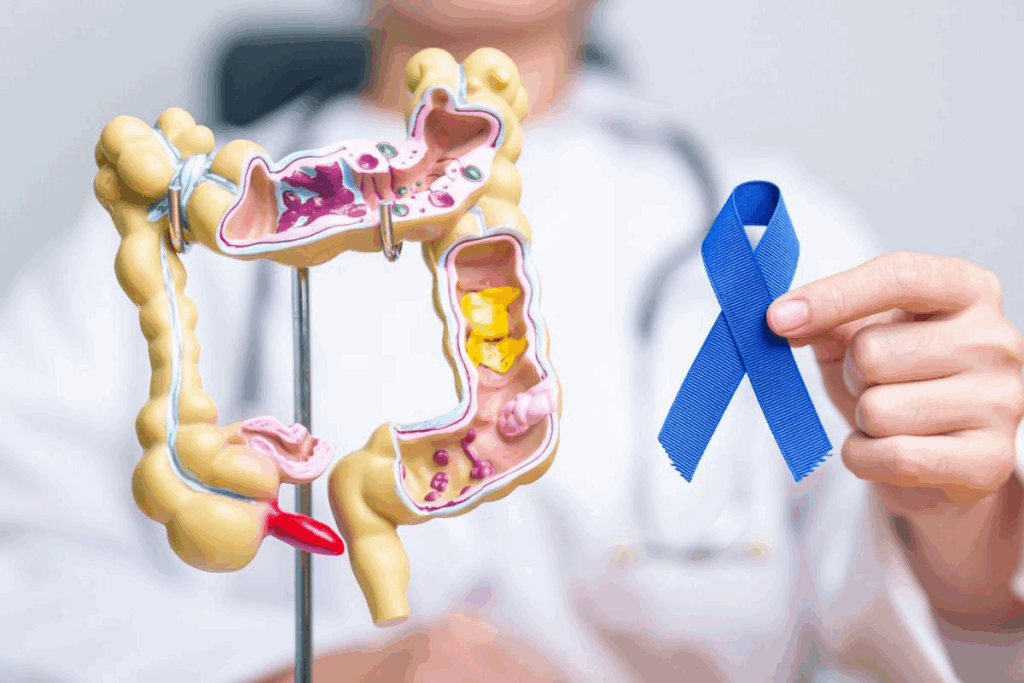Last Updated on October 30, 2025 by Bilal Hasdemir

The human body’s digestive system is complex. The colon and rectum are key in getting rid of waste. The large intestine, a six-foot-long muscular tube, has several sections.Discover what side is your colon on, its position in the body, and how it relates to cancer risks.
The colon runs along both sides of the abdominal cavity. The right side includes the cecum, ascending colon, and hepatic flexure. The left side has the splenic flexure, descending colon, sigmoid colon, and rectum. The sigmoid colon, shaped like an S, is between the descending colon and the rectum. It’s mainly in the left lower abdomen and pelvis.
Knowing where the colon and sigmoid colon are is key for finding and treating colon cancer. Liv Hospital focuses on being competitive globally and offers the latest treatments for colon cancer.

The colon is a key part of our digestive system. It’s split into segments, each with its own job. Knowing about the colon’s anatomy helps doctors find and treat diseases like sigmoid colon malignancy.
The colon, or large intestine, is important for digestion. It absorbs water, stores, and gets rid of waste. It’s divided into four parts: the ascending, transverse, descending, and sigmoid colon.
The sigmoid colon is the last part. It links to the rectum and anus. This makes it key for waste passage.
Each colon segment has its own role. The ascending colon absorbs water and salts. The transverse colon does the same.
The descending colon holds waste until it goes to the sigmoid colon. The sigmoid colon is important because problems here, like tumor colon sigmoid, can affect health a lot.
Studies show left and right colon cancers are different. They affect how the cancer grows and how it’s treated. Knowing where the sigmoid location is and its surroundings is key for good treatment.

Understanding the digestive tract, including the colon, is key. The colon, or large intestine, absorbs water and salts. It then removes waste from the body.
The colon is on both sides of the belly. The right side has the cecum, ascending colon, and hepatic flexure. The cecum is a pouch at the large intestine’s start. It’s in the right lower belly.
The transverse colon crosses the belly from right to left. It’s below the stomach and liver. It links the ascending and descending colon.
The left side has the splenic flexure, descending colon, sigmoid colon, and rectum. The descending colon goes down from the splenic flexure on the left. The sigmoid colon, shaped like an S, follows it to the rectum.
Knowing the descending and sigmoid colon are on the left helps in treating conditions like sigmoid malignancy and descending colon cancer.
| Colon Segment | Location | Function |
| Cecum | Right lower quadrant | Beginning of the large intestine |
| Ascending Colon | Right side of the abdomen | Continues upwards from the cecum |
| Transverse Colon | Crosses the abdomen from right to left | Connects ascending and descending colon |
| Descending Colon | Left side of the abdomen | Extends downwards from the splenic flexure |
| Sigmoid Colon | Left lower abdomen and pelvis | Leads to the rectum |
Knowing each colon segment’s location and function is vital. It helps understand health risks like cancer sigmoide. Understanding the colon’s anatomy highlights the importance of colon health and regular screenings.
The sigmoid colon is found between the descending colon and the rectum. It has an S-shape and is key to our digestive system. It mainly holds feces until they are passed out of the body.
The sigmoid colon is mostly in the left lower abdomen and pelvis. Knowing its location helps doctors understand its role and treat problems like adenocarcinoma sigmoid colon cancer and malignant tumor of sigmoid colon.
The sigmoid colon’s S-shape helps it store feces until they are ready to go. It moves these through muscular contractions called peristalsis towards the rectum. Its shape and function make it essential for digestion.
The sigmoid colon is surrounded by organs and tissues in the pelvic cavity. Knowing how it relates to these is key for spotting cancer in the sigmoid colon. It’s near the rectum, bladder, and reproductive organs, which is important for surgery and diagnosis.
| Anatomical Feature | Description | Clinical Significance |
| Location | Left lower abdomen and pelvis | Critical for diagnosing sigmoid colon cancer |
| S-Shaped Structure | Stores feces until elimination | Important for understanding physiological function |
| Relationship to Surrounding Organs | Closely related to rectum, bladder, and reproductive organs | Vital for surgical planning and diagnosing cancer spread |
Many conditions can harm the sigmoid colon, leading to serious problems if not treated. It’s important to know about these issues to keep the colon healthy. This helps avoid serious problems like sigmoid colon cancer.
Diverticulosis causes small pouches in the sigmoid colon wall. If these pouches get inflamed, it’s called diverticulitis. Symptoms include stomach pain, fever, and changes in bowel habits. Untreated diverticulitis can cause abscesses or perforations.
Inflammatory bowel disease (IBD) can hit the sigmoid colon. Ulcerative colitis often starts in the rectum and spreads to the sigmoid colon. It causes inflammation and ulcers. Symptoms are diarrhea, rectal bleeding, and stomach pain. It’s key to manage IBD to avoid long-term damage and lower cancer risk.
Benign polyps grow on the colon or rectum lining. Most are harmless, but some can turn cancerous. Regular screenings are vital to find and remove these polyps before they turn cancerous. Other non-cancerous growths, like lipomas or leiomyomas, can also appear in the sigmoid colon, but they’re rare.
The sigmoid colon is a key part of the large intestine. Keeping it healthy is essential. By knowing about common issues, people can take steps to prevent problems and lower the risk of sigmoid colon cancer.
Adenocarcinoma, the most common type of sigmoid colon cancer, is a big concern. It’s important to know about it and catch it early. This knowledge helps in managing the disease effectively.
Adenocarcinoma starts in the glandular tissue of the sigmoid colon. It’s the most common colorectal cancer type. It grows from abnormal cells in the glandular epithelium, possibly spreading deeper into the colon wall.
Risk factors include age, family history, and genetic syndromes. Catching it early through screening can greatly improve survival chances.
It’s key to know the difference between benign and malignant tumors. Benign tumors are non-cancerous and don’t spread. Malignant tumors, on the other hand, are cancerous and can spread to other parts of the body.
“The distinction between benign and malignant tumors is critical for determining the prognosis and treatment plan for patients with sigmoid colon neoplasms.”
The staging of sigmoid colon cancer depends on how far the tumor has spread. The TNM system is used to measure this. It looks at the tumor size, lymph node involvement, and if it has metastasized.
Getting the staging right is key for knowing the prognosis and treatment options for sigmoid colon cancer patients.
Knowing the risk factors for sigmoid and descending colon cancer is key. It helps in early detection and prevention. Several factors can lead to these cancers. Being aware of them can help individuals take steps to lower their risk.
Age is a big risk factor for these cancers. The risk goes up after 50, with most cases in people over 60. Ethnicity and where you live also matter, with some groups facing higher risks.
What you eat and how you live affects your risk. Eating a lot of red and processed meats and not enough fiber increases risk. Physical inactivity and obesity also raise the risk. But, eating more fruits, veggies, and whole grains, and staying active can help lower it.
Genetics are a big part of the risk. If you have a family history of colon cancer, you’re at higher risk. Certain genetic syndromes, like Lynch syndrome, also raise the risk a lot.
Chronic inflammation in the colon, like ulcerative colitis and Crohn’s disease, increases cancer risk. The risk is higher if you’ve had the disease for a long time or have a family history of colon cancer.
Understanding these risk factors helps individuals take steps to lower their risk. This includes living a healthy lifestyle, knowing your family history, and managing chronic conditions.
Spotting sigmoid colon cancer early is key. Knowing the first signs, like changes in bowel habits and pain, can help a lot. This can lead to better treatment results.
Sigmoid colon cancer often shows up with small symptoms that are easy to miss. Look out for persistent fatigue, unexplained weight loss, and feeling generally unwell. These signs are important, even more so if you have a family history of colon cancer.
Changes in how you go to the bathroom are common signs. You might feel constipated, diarrhea, or like you’re not fully emptying your bowels. Seeing blood in your stool or black, tarry stools could mean a tumor in the sigmoid colon.
Abdominal pain or discomfort is a symptom to watch. The pain might stay the same or come and go. It often feels like it’s in the lower left side because of where the sigmoid colon is. As the tumor grows, it can block things, causing severe pain and cramps.
Seeing blood in your stool is a big warning sign. Bright red blood on your stool or toilet paper could mean a tumor in the sigmoid colon. You might also feel a lump in your belly, though this is less common.
| Symptom | Description |
| Changes in Bowel Habits | Constipation, diarrhea, or feeling of incomplete evacuation |
| Abdominal Pain | Localized to lower left abdomen, can be persistent or intermittent |
| Rectal Bleeding | Bright red blood on stool or toilet paper |
Spotting these symptoms early can greatly improve treatment chances. If you or someone you know is showing these signs, seeing a doctor right away is very important.
Getting an accurate diagnosis is key to treating sigmoid colon malignancies well. To find out if you have cancer in the sigmoid colon, doctors use several tests. These tests help see if the cancer is there and how big it is.
There are a few ways to find out if you have sigmoid colon cancer:
Colonoscopy is the best way to find sigmoid colon cancer. It lets doctors see and take a sample of any bad spots.
How you’ll be treated for sigmoid colon cancer depends on how far it has spread. Treatment options include:
| Treatment Modality | Description |
| Surgery | Removing the tumor and part of the colon. |
| Chemotherapy | Drugs to kill cancer cells, used after surgery. |
| Targeted Therapy | Treatment that focuses on specific cancer traits. |
The outlook for sigmoid colon cancer changes with the stage. If caught early, the chances of survival are much better.
Knowing survival rates by stage helps doctors and patients make better choices about treatment.
| Cancer Stage | 5-Year Survival Rate |
| Stage I | 90-100% |
| Stage II | 70-90% |
| Stage III | 40-70% |
| Stage IV | 10-30% |
To keep your colon healthy and prevent cancer, you need to make lifestyle changes and get regular check-ups. Eating right and exercising often can lower your risk of getting sigmoid colon cancer. This includes types like malignant tumor of sigmoid colon and ca sigmoid colon.
Getting cancer early and treating it quickly can help a lot. Knowing the risks and symptoms helps you act early to keep your colon healthy. It’s important to get screened regularly to catch problems early.
Liv Hospital is dedicated to giving the latest treatments and care for colon cancer patients. By staying informed and taking steps to prevent it, you can lower your risk of sigmoid colon cancer. This helps improve your overall health and well-being.
The sigmoid colon is shaped like an S. It’s found between the descending colon and the rectum. It’s mainly in the left lower abdomen and pelvis.
Left-sided and right-sided colon cancers have different traits. This affects their biomarkers, how aggressive they are, and how well they respond to treatment.
Several factors increase the risk of sigmoid and descending colon cancer. These include age, diet, lifestyle, genetics, and inflammatory conditions.
Symptoms include changes in bowel habits, abdominal pain, and rectal bleeding. Knowing these symptoms is key to getting early treatment.
Diagnosing sigmoid colon cancer involves screening and diagnostic tests like colonoscopy.
Treatments include surgery, chemotherapy, and targeted therapy. The choice depends on the cancer’s stage.
Knowing the sigmoid colon’s anatomy is key for diagnosing and treating cancer. It helps understand how far the cancer has spread.
Yes, a healthy lifestyle can help prevent colon cancer. This includes a balanced diet, exercise, and regular screenings.
Sigmoid colon cancer is mostly adenocarcinoma. It’s a serious health issue. Knowing the difference between benign and malignant tumors is vital for early detection and treatment.
The colon’s location in the abdominal cavity is important. It helps identify symptoms and risks of colon cancer.
Andrews, S., et al. (2013). Gallstone size e related to the incidence of post-cholecystectomy retained bile duct stones. Surgery Journal, 5(3), 143-147. Retrieved from https://www.sciencedirect.com/science/article/pii/S1743919113000484
Subscribe to our e-newsletter to stay informed about the latest innovations in the world of health and exclusive offers!
WhatsApp us